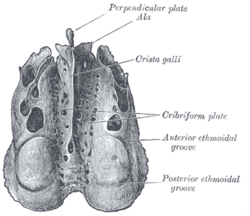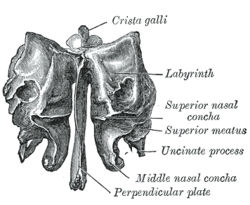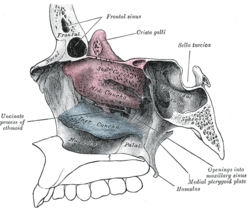Ethmoid bone
The olfactory bone is a smaller bone in the anterior cranial fossa. It is divided into three main sections.
Anatomical Structures
Lamina cribrosa
A horizontally placed perforated plate, reminiscent of a sieve (lat. cribrum – sieve). Its position is between the orbital parts frontal bone and in front of the alae minores sphenoid bone. At the same time, its upper surface communicates with the cranial cavity and its lower surface with the nasal cavity. The tiny openings are called foramina cribrosa', where the olfactory n. olfactorius penetrates. In the middle of the disc, the crista galli – a conspicuous sagittal protrusion – protrudes into the cranial cavity.
Lamina perpendicularis
It forms the vertical plate of the olfactory bone, descending caudally from the lamina cribrosa to the upper anterior part of the nasal septum, which it partly forms.
Labyrinthi ethmoidales
The olfactory labyrinths are paired formations of bony cavities called cellulae ethmoidales. The sinuses descend from the edges of the lamina cribrosa, where the outer surface forms part of the inner wall of the orbital (lamina orbitalis'', or lamina papyracea) and the side walls of the nasal cavity. Divided into:
- cellulae anteriores' - opening into the space meatus nasi medius (middle nasal passage);
- cellullae mediae - opens together with cellulae anteriores into meatus nasi medius;
- cellulae posteriores - opens into the meatus nasi superior (upper nasal passage) together with the sinus sphenoidalis.
They are lined with mucous from the nasal cavity and are considered part of the paranasal sinuses.
Foramen ethmoidale anterius et posterius are two openings at the edge of the lamina orbitalis in connection with the os frontale. They contain blood vessels and nerves.
Labyrinths are generally in contact with:
- in front with os lacrimale;
- cranially with os frontale;
- dorsocranially ala minor ossis sphenoidalis;
- behind with os palatinum;
- caudally with maxilla.
The most common variation of the olfactory bone
Processus alares (Hyrtl), which depart from the front edge of the crista galli and surround the foramen caecum, or ossa internasalia – small, flat bones connecting the lamina perpendicularis with ossa nasalia.
Nasal shells
Below the labyrinth are three nasal shells:
- concha nasalis superior - upper nasal shell;
- concha nasalis media - middle nasal shell;
- both are parts of the olfactory labyrinth, the upper part is anchored in it, the lower part is free;
- concha nasalis inferior - the lower nasal shell is a separate thin, flat bone, larger and fixed to the wall of the nasal cavity by its upper edge.
The most common variation of the lower shell
The bone may be taken into the maxilla and fuse with it or with the olfactory bone.
Links
Related Articles
References
- ŠIHÁK, Radomír. Anatomy I. 2. edition. Prague : Grada, 2001. 516 pp. pp. 144-147. ISBN 978-80-7169-970-5.






